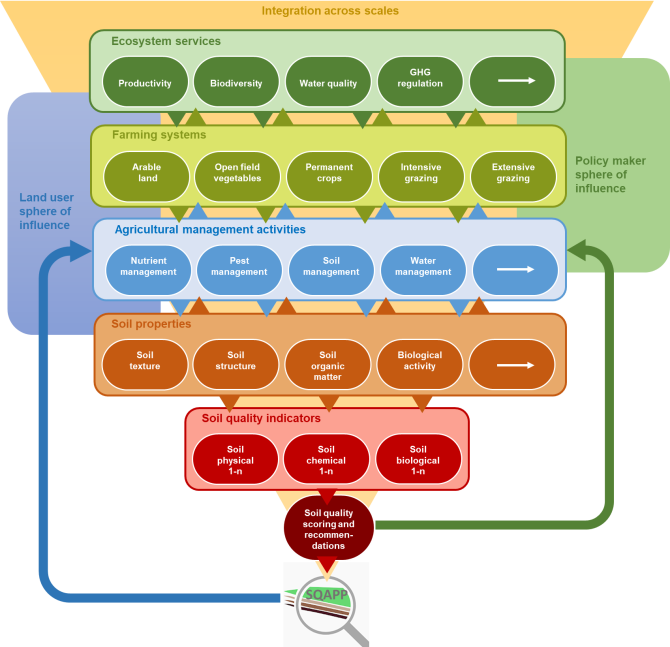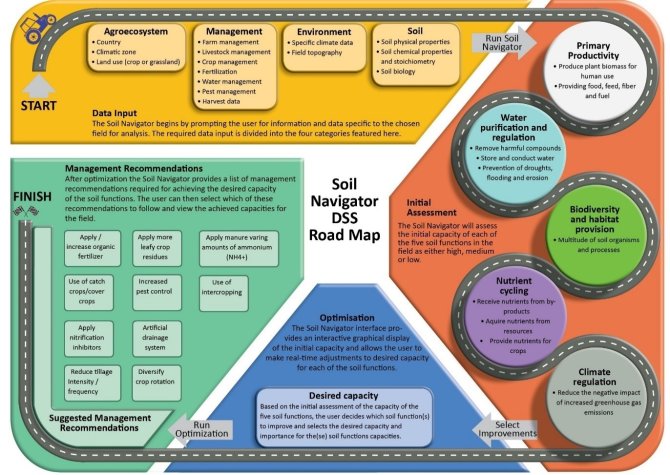Soil quality at your fingertips (SSC)
Two Soil Science cluster projects developed tools for land users and managers to get a better grip on soil quality, and understand management decision consequences: iSQAPER (http://isqaper-project.eu/) and LANDMARK (http://landmark2020.eu/).
Summary
Intensive agriculture maximises production at expense of soil quality, undermining resilience and future productivity. However, there are barriers to implementing new sustainable practices, such as the lack of tools to understand consequences on soil health. Two EU-funded, Soil Science cluster-led projects developed tools for land users and managers to better grasp soil quality and management impact: iSQAPER and LANDMARK. The projects used distinct innovative approaches with heavy involvement of final stakeholders, along with substantial efforts into communicating scientific results to the broader public.
Background
Conventional agricultural practices come with environmental consequences (Tilman et al., 2001), challenging farmers and land managers to balance societal needs for food and fibre with sustainability. However, barriers to implementing new sustainable practices include a lack of tools for managers to understand management consequences on soil quality (Schröder et al., 2020). Soil quality concepts stress the multiple ecosystem services delivered by soil (Bünemann et al., 2018).
The core objective of both projects was to develop tools to understand and manage the multiple dimensions of soil quality, but the projects used diverse and innovative approaches, combining established and new methodologies with state-of-the-art technology.
iSQAPER
Coordinated by SLM, iSQAPER brought together 26 diverse partner organisations across Europe and China. The project started with a comprehensive soil quality review (Bünemann et al., 2018) and explored cost-effective, novel biological methods for soil quality assessment (Bongiorno et al., 2019a-c; 2020). Information on effects of management practices on soil quality were gathered from experimental fields and case studies on farms in Europe and China (Zai et al., 2018; Alaoui et al., 2020). These studies led to the development of the SQAPP mobile app (Fleskens et al., 2020; Figure 1), which was developed, tested, evaluated and improved by farmers, scientists, practitioners, agricultural service providers and policy makers. The app assesses soil quality based on soil property and soil threat indicator values derived from global maps or user input and recommends alternative agricultural land management practices (AMPs) addressing low-scoring indicators. SQAPP[1] is freely available for download on mobile devices in 14 languages, can be used anywhere in the world and can be deployed in education and citizen science initiatives.

LANDMARK
LANDMARK, coordinated by SBL, was a collaboration between experts from 14 European countries, Brazil and China. To quantify soil multifunctionality, LANDMARK built upon the Functional Land Management framework (Schulte et al., 2014) which conveys the idea that while one soil cannot perform all soil functions at high levels, it can provide a number of them, potentially resulting in landscapes with varied soils providing all soil functions.

The project started with conducting workshops involving 400+ stakeholders to learn their understanding of soil functions (Bampa et al., 2019). Scientists and stakeholders worked together to gather data from European field experiments and surveys to create models for assessing five essential soil functions (Figure 2) (Schröder et al., 2016; Van de Broek et al., 2019; van Leeuwen et al., 2019). This culminated in the creation of a decision support system tool, the Soil Navigator[2], to help farmers, soil managers and advisory agencies maximise soil multifunctionality (Debeljak et al. 2019) (Figure 2).
Scientific and social highlights and impact
The projects produced numerous scientific publications[3,4] and policy briefs[5], paving the way for future schemes and research (Bünemann et al., 2018; Schulte et al., 2014) and reaching national and European policy makers (O'Sullivan et al., 2017). The iSQAPER and LANDMARK projects disseminated results to stakeholders and to the broader public through demonstration events (Barão et al., 2019), professional publications, infographics, videos, social media[YouTube channel, Vimeo, Facebook, LinkedIn and Twitter], traditional media[6] and policy-related blogs[7, 8, 9, 10, 11].
The Soil Navigator and SQAPP tools can enhance sustainable agricultural management by taking stakeholders and students through evaluation of soil quality and functions. SQAPP has 2000+ registered users who have applied SQAPP in 8000+ locations.
Future perspectives and developments beyond the two projects
The Soil Science cluster will continue to advance knowledge about the effect of different agronomic practices on soil quality by further developing the SQAPP and the Soil Navigator, engaging in new projects[1], developing new methods and platforms for soil biological indicators and fostering collaborations with other institutes and organizations.